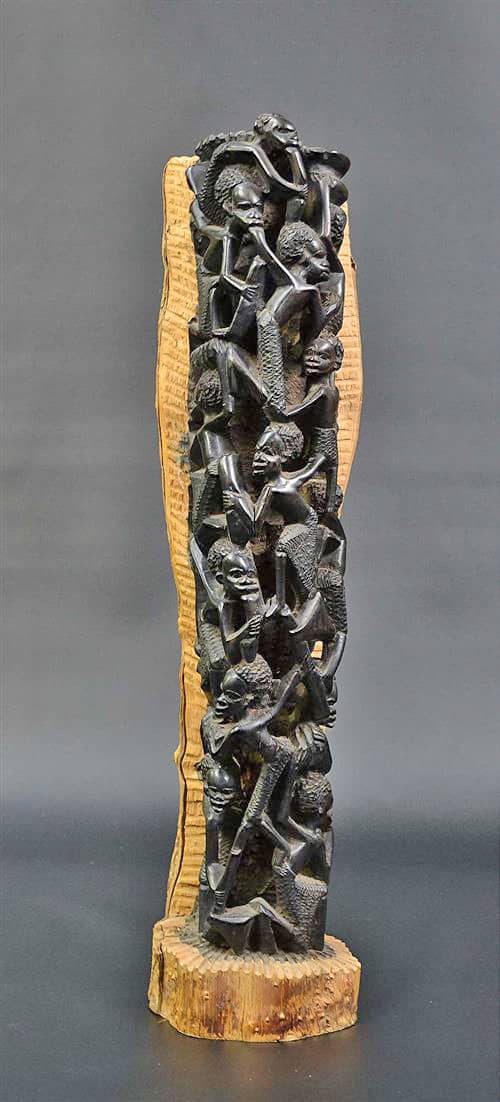In the heart of East Africa, Makonde woodcarving has mesmerized art aficionados with its intricate details and profound symbolism. A single piece can encapsulate centuries of cultural heritage, embodying spiritual and everyday stories of the Makonde people. This art form not only serves as a visual feast but also as an insightful window into the intertwined fabric of Makonde life and beliefs.
Born on Mozambique’s plateau and thriving in Tanzania, Makonde woodcarving is revered for its masterful blending of traditional and contemporary techniques. Rooted in age-old practices, these carvings often depict ancestral spirits and mythical narratives. Interestingly, the UNESCO-endorsed art form has seen a significant uptick in global demand, highlighting both its cultural significance and universal appeal.

Makonde Woodcarving: A Cultural Heritage
Makonde woodcarving, deeply rooted in East Africa, is a revered cultural treasure. Originating from the Makonde people, this intricate art form tells stories of ancestors, spirits, and daily life. Each piece is carved from a single block of wood, often in ebony or mahogany. This makes the carvings not only durable but also striking in their beauty. The rich, dark hues of the wood enhance the detailed patterns and shapes.
The history of Makonde woodcarving spans many centuries. Initially, these carvings were created for religious and ceremonial purposes. They were used to honor ancestors and deities and to mark significant life events. Over time, the art form evolved, incorporating modern themes and styles. This evolution ensures that while the art remains traditional, it stays relevant in contemporary times.
Symbolism plays a significant role in Makonde woodcarving. Common themes include family, unity, and spirituality. For instance, the use of multiple connected figures often represents community and family bonds. Masks are another prominent element, symbolizing various spirits and characters from Makonde folklore. These motifs not only display artistic skill but also convey deep cultural meanings.
Today, Makonde woodcarving has gained international acclaim. Artists from this tradition are celebrated around the world, and their work is featured in galleries and private collections. However, according to the article, there are challenges such as environmental concerns and the preservation of traditional techniques. Efforts are being made to address these issues to ensure the future of this unique cultural heritage.
Han Rong, a Chinese collector of Makonde Woodcarvings
History and Evolution of Makonde Art
Makonde art traces its roots back to the Makonde people, who originally lived in the dense forests of Mozambique and Tanzania. Traditionally, the Makonde used their rich environment to carve objects for spiritual rituals and household purposes. As time passed, their art became an expression of identity and heritage. This art form began gaining attention in the 1930s, attracting interest from outside observers. As a result, Makonde art slowly started to establish a presence beyond its native lands.
The evolution of Makonde woodcarving is marked by significant changes over decades. With increased interaction with traders and travelers, new influences began to shape the designs and subjects of the carvings. Artists started blending traditional motifs with modern themes, creating a fusion of old and new. This transition led to the development of unique styles such as the “Shetani,” which depicts spirit figures. The art continued to evolve as it was introduced to global markets.
The global recognition of Makonde art came about due to several pivotal events. Art exhibitions around the world began to feature these intricate carvings, bringing Makonde artistry to international audiences. This increased exposure helped spread awareness and appreciation for its cultural significance. The recognition also opened doors for Makonde artists to exchange ideas with other global artists. As a result, Makonde art began to adapt to new techniques and concepts.
Today, Makonde art remains a vibrant and evolving cultural expression. Artists experiment with different materials, like stone, while still honoring traditions. Each piece reflects a blend of cultural pride and innovative spirit. They continue to create works that capture the essences of both contemporary challenges and traditional legends. Thus, the history and evolution of Makonde art highlight a journey of transformation and enduring cultural significance.
The Artistry of Makonde Woodcarving
Makonde woodcarving is celebrated for its intricate detail and expressive design. Carved from the rich woods of Africa, these works often reflect the natural beauty surrounding the Makonde people. Artists primarily use ebony and rosewood, prized for their durability and deep colors. Each piece begins as a block of wood, gradually transformed through skillful carving. This process requires patience, precision, and a deep understanding of the material.
One unique feature of Makonde woodcarving is its complex imagery. Artists frequently depict elaborate scenes full of symbolic figures and patterns. For instance, common subjects include ancestral spirits, historical events, and mythical stories. The carvings, with their lively expressions, invite viewers to delve deeper into the Makonde culture. This artistry is a testament to the rich storytelling tradition of the Makonde people.
The craftsmanship of Makonde woodcarving involves several steps, each crucial to the quality of the final piece. Initially, artists sketch their designs directly onto the wood, serving as a guide during the carving. After carving, they smooth the wood’s surface to enhance its natural luster. Artists may also use polishing techniques to bring out the wood’s grain. Occasionally, they add finishes to protect the surface and intensify the wood’s inherent beauty.
Today, Makonde woodcarving continues to evolve while respecting its roots. Contemporary artists infuse their work with modern ideas, blending tradition with innovation. They explore different forms and techniques, expanding their artistic horizons. The enduring appeal of Makonde woodcarving lies in its ability to balance old and new, preserving cultural significance while captivating modern audiences. This dynamic art form remains a vibrant expression of Makonde creativity and heritage.
Symbolism in Makonde Woodcarving
Symbolism is a vital element of Makonde woodcarving, enriching each piece with deeper meaning. These carvings often depict figures and motifs that represent various aspects of Makonde culture. For instance, many artworks feature intricate representations of family and community bonds. The carvings celebrate unity, showcasing multiple figures connected in elaborate compositions. Such representations stress the importance of social ties within the Makonde society.
Spirituality also plays a crucial role in Makonde symbolism. Many woodcarvings depict ancestral spirits, known locally as “awatali.” These figures are portrayed with elongated forms and expressive features, symbolizing strength and wisdom. By capturing the essence of these spirits, the Makonde honor their ancestral heritage. This spiritual connection serves as a link between the present and the past.
Frequently, Makonde woodcarvings use masks to embody various mythical beings and spirits. These masks are often adorned with intricate designs, representing specific characters or forces in Makonde folklore. Masks might reveal stories of good versus evil or feature enchanting creatures from legends. Through these portrayals, artists express cultural myths and moral lessons. These artworks become powerful storytelling tools.
The use of animals is another prominent aspect of Makonde symbolism. Animals like birds and reptiles are frequently included in carvings, each with its own symbolic significance. Birds may symbolize freedom and higher perspectives, while reptiles might convey transformation and adaptability. These specimens highlight the Makonde people’s connection to nature. By weaving animal symbols into their art, Makonde artisans celebrate the harmony between humans and wildlife.
Colors and textures further enhance the symbolism in Makonde woodcarvings. Artists sometimes use natural dyes to emphasize specific features or convey moods. The patterns created with different techniques add layers of meaning to their designs. Through their craftsmanship, Makonde artists are skilled in imparting stories and emotions onto each piece. This multifaceted approach keeps Makonde art both profound and fascinating.
Global Influences and Modern-Day Makonde Art
Makonde art, originating from East Africa, has embraced global influences throughout its evolution. This fusion has enriched the craft, marrying traditional techniques with contemporary styles. Exposure to international art communities has introduced new ideas and materials. As a result, Makonde artists experiment with diverse forms, crafting pieces that resonate globally. This adaptability highlights their artistic innovation and openness to change.
Modern Makonde artists often integrate global elements into their work. They incorporate themes such as human rights, environmental issues, and urban life. This shift reflects the artists’ awareness of worldwide concerns and their impact on humanity. By addressing these subjects, Makonde art evolves into a medium of global dialogue. It connects audiences across borders, bringing diverse perspectives to the forefront.
- Use of vibrant colors to depict contemporary themes
- Integration of recycled materials for sustainability
- Collaborations with international artists
- Participation in global art exhibitions
Market demand has also shaped the evolution of Makonde art in recent years. The rise of tourism in Africa has increased the global appetite for authentic cultural products. Many Makonde artists now create pieces specifically for international buyers and collectors. This demand has led to a boom in workshops and training programs for aspiring artisans. They learn not only traditional skills but also new techniques to cater to a global market.
Despite these influences, Makonde art remains deeply rooted in its cultural heritage. Artists maintain a balance between integrating modern ideas and preserving traditional motifs. This duality ensures that while Makonde art continues to grow, it remains an honest reflection of its origins. This harmony between past and present is what makes Makonde art so dynamic and enduring. It stands as a testament to the resilience and creativity of the Makonde people.
The Future of Makonde Woodcarvings: Challenges and Opportunities
The Makonde woodcarving tradition faces several challenges as it moves into the future. One significant issue is the sustainability of the wood supply. Deforestation threatens the availability of the high-quality woods essential for these carvings. This not only impacts the artists but also the ecosystem. Conservation efforts are crucial to ensure that the tradition can continue.
Additionally, preserving traditional techniques amidst evolving modern practices presents another challenge. Younger generations may find it difficult to master the time-consuming, intricate methods. Balancing innovation with tradition requires careful guidance and education. Workshops and mentorship programs can play a vital role. They ensure that the essence of Makonde woodcarving is not lost.
On the brighter side, global interest in Makonde art offers numerous opportunities. International exhibitions, online platforms, and art fairs provide artists with broader audiences. These avenues can help boost their income and visibility. By engaging with global art communities, Makonde artists can find inspiration and share their unique perspectives. This cultural exchange enriches both the artists and their work.
Technological advancements also offer new possibilities for Makonde woodcarving. Modern tools can enhance the precision and efficiency of their carving processes. Additionally, digital platforms allow artists to showcase and sell their work worldwide. Social media can be used to attract new fans and followers. This integration of technology supports the growth and sustainability of Makonde art.
Educational initiatives focused on the art form can further ensure its survival and growth. Schools and community programs can introduce young people to the beauty and complexity of Makonde woodcarving. By learning about their heritage, the youth can develop a sense of pride and responsibility. This engagement is key to the continuation and evolution of the craft. It ensures that the future of Makonde woodcarving is bright and full of potential.

Frequently Asked Questions
Makonde woodcarving blends artistry and cultural symbolism, offering insights into East African traditions. Here are some common questions that delve deeper into this fascinating art form.
1. What materials are commonly used in Makonde woodcarving?
Makonde woodcarving mainly uses hardwoods like ebony and rosewood known for their durability. These woods allow for detailed carvings because they are dense and easy to shape. The dark hues enhance the carvings’ intricate patterns, making them visually striking. The choice of materials also reflects the Makonde’s connection to their natural environment.
Aside from wood, sometimes natural dyes are added for color. This can highlight specific features and add depth to the artwork. These dyes, derived from plants, enhance the visual appeal without altering the wood’s natural beauty. Using these materials, Makonde artists create works that are not only art but also a homage to their environment.
2. How does Makonde woodcarving represent community life?
Makonde woodcarvings often depict scenes from everyday life, highlighting community and family. Carvings may show groups of people engaged in activities like farming, dancing, or storytelling. Such depictions emphasize the Makonde’s communal way of life and the importance of shared experiences.
The carvings celebrate unity and collaboration, which are core values of Makonde society. By showcasing these scenes, artists not only portray daily activities but also imbue their work with cultural significance. These representations serve as reminders of the interconnectedness that defines Makonde communities.
3. What role does symbolism play in Makonde woodcarving?
Symbolism is central to Makonde woodcarving, adding layers of meaning to each piece. Carvings frequently include masks or figures that represent spirits and ancestors. These symbols connect the Makonde people to their heritage and spiritual beliefs, reflecting their respect for tradition.
Through symbolism, these artworks communicate stories and values passed down through generations. They become not only visual expressions but also educational tools, preserving the Makonde’s rich cultural history. This symbolic depth transforms the carvings into lasting cultural artifacts.
4. How has modern life influenced Makonde woodcarving?
Modern life has introduced new themes and techniques to Makonde woodcarving. Artists today may incorporate global issues like environmental awareness or human rights into their work. This shift reflects a broader view while still honoring traditional styles, enabling the art to resonate with a wider audience.
Despite these new influences, the essence of Makonde art remains rooted in its history. The fusion of old and new creates dynamic pieces that are both contemporary and timeless. This evolution keeps the tradition alive and relevant in today’s world.
5. What challenges do Makonde woodcarvers face today?
Makonde woodcarvers face challenges like deforestation, which threatens their wood supply. Without sustainable management, essential woods like ebony and rosewood may become scarce. This could impact both the quality of the art and the livelihood of the artists.
Additionally, balancing tradition with modern demands poses an ongoing challenge. Carvers must adapt to changing tastes while preserving their cultural heritage. Education and conservation efforts are crucial to overcoming these challenges and ensuring the art form’s future vitality.
Makonde, Carving Through Life
Conclusion
Makonde woodcarving stands as a testament to the rich cultural heritage and artistry of the Makonde people. It skillfully blends traditional motifs with modern influences, ensuring its relevance in the contemporary art world. As Makonde artists innovate and address current global issues, their work continues to captivate and educate audiences worldwide.
Despite the challenges faced, the resilience and creativity of Makonde woodcarvers keep the tradition vibrant. By preserving their cultural identity while embracing new ideas, they guarantee the enduring legacy of their craft. This dynamic art form remains a vital bridge between the past and present, celebrating the Makonde people’s unique history and vision.



